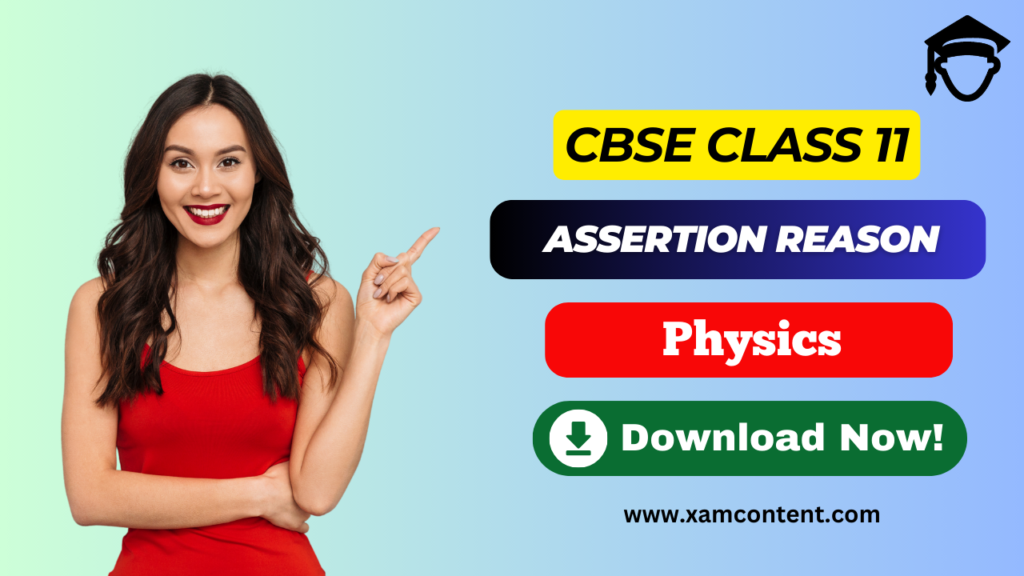Last Updated on April 24, 2025 by XAM CONTENT
Hello students, we are providing assertion reason questions for class 11. Assertion Reason questions are the new question format that is introduced in CBSE board. The resources for assertion reason questions are very less. So, to help students we have created chapterwise assertion reason questions for class 11 Physics. In this article, you will find assertion reason questions for CBSE Class 11 Physics Chapter 4 Laws of Motion. It is a part of Assertion Reason Questions for CBSE Class 11 Physics Series.
| Chapter | Laws of Motion |
| Type of Questions | Assertion Reason Questions |
| Nature of Questions | Competency Based Questions |
| Board | CBSE |
| Class | 11 |
| Subject | Physics |
| Useful for | Class 11 Studying Students |
| Answers provided | Yes |
| Difficulty level | Mentioned |
| Important Link | Class 11 Physics Chapterwise Assertion Reason |
Assertion Reason Questions on Laws of Motion
Assertion Reason Questions
Directions:
Each of the following questions consists of two statements: an Assertion (A) and a Reason (R). Answer them by selecting the correct option:
(a) Both Assertion (A) and Reason (R) are true, and Reason (R) is the correct explanation of Assertion (A).
(b) Both Assertion (A) and Reason (R) are true, but Reason (R) is not the correct explanation of Assertion (A).
(c) Assertion (A) is true, but Reason (R) is false.
(d) Assertion (A) is false, but Reason (R) is true.
Q1. Assertion (A): A passenger standing in a bus falls backward when the bus starts suddenly.
Reason (R): The inertia of rest tends to resist the change in motion.
Answer: (a) Both A and R are true, and R is the correct explanation of A.
Difficulty Level: Moderate
Q2. Assertion (A): A body can have acceleration even if no force is acting on it.
Reason (R): According to Newton’s second law, F=ma.
Answer: (c) Assertion is false, but Reason is true.
Difficulty Level: Moderate
Q3. Assertion (A): The tension in a light string connecting two masses on a smooth pulley is the same on both sides.
Reason (R): A light, inextensible string transmits the same force throughout its length in the absence of friction.
Answer: (a) Both A and R are true, and R is the correct explanation of A.
Difficulty Level: Moderate
Q4. Assertion (A): Action and reaction forces act on the same body.
Reason (R): Newton’s third law says that to every action, there is an equal and opposite reaction.
Answer: (c) Assertion is false, but Reason is true.
Difficulty Level: Tough
Q5. Assertion (A): Friction always acts in the direction of motion of the body.
Reason (R): Friction opposes the relative motion between two surfaces.
Answer: (b) Both A and R are true, but R is not the correct explanation of A.
Difficulty Level: Tough
Also check
- Waves Class 11 Assertion Reason Questions Physics Chapter 14
- Oscillations Class 11 Assertion Reason Questions Physics Chapter 13
- Kinetic Theory Class 11 Assertion Reason Questions Physics Chapter 12
- Thermodynamics Class 11 Assertion Reason Questions Physics Chapter 11
- Thermal Properties of Matter Class 11 Assertion Reason Questions Physics Chapter 10
- Mechanical Properties of Fluids Class 11 Assertion Reason Questions Physics Chapter 9
- Mechanical Properties of Solids Class 11 Assertion Reason Questions Physics Chapter 8
- Gravitation Class 11 Assertion Reason Questions Physics Chapter 7
- System of Particles and Rotational Motion Class 11 Assertion Reason Questions Physics Chapter 6
- Work, Energy, and Power Class 11 Assertion Reason Questions Physics Chapter 5
- Laws of Motion Class 11 Assertion Reason Questions Physics Chapter 4
- Motion in a Plane Class 11 Assertion Reason Questions Physics Chapter 3
- Motion in a Straight Line Class 11 Assertion Reason Questions Physics Chapter 3
- Units and Measurements Class 11 Assertion Reason Questions Physics Chapter 2
🚀 Boost Your Exam Prep: Get assertion reason questions for all subjects (Class 6-12) now!
👉 Explore more resources on CBSE Class 11
Topics from which assertion reason questions may be asked
- Newton’s Laws of Motion
- Free body diagrams
- Friction and circular motion
Newton’s third law explains why rockets launch — every action has an equal and opposite reaction.
Assertion reason questions from the above given topic may be asked.

Frequently Asked Questions (FAQs) on Laws of Motion Assertion Reason Questions Class 11
Q1: What is the importance of Laws of Motion in Class 11 Physics?
A1: It forms the basis for various real-life applications and is crucial for JEE/NEET level conceptual clarity.
Q2: Are assertion reason questions asked in CBSE exams?
A2: Yes, CBSE has introduced competency-based formats which include assertion reason questions to test conceptual understanding.
Q3: How to prepare assertion reason questions from Laws of Motion?
A3: Focus on key definitions, cause-effect relationships, and conceptual reasoning instead of just memorizing facts.
Q4: Can numerical topics appear in assertion reason format?
A4: Yes, concepts from numerical topics like laws, formulas, or effects of parameter change are often asked.
Q5: Where can I find more assertion reason questions on Laws of Motion?
A5: Visit xamcontent.com and physicsgurukul.com for chapterwise assertion reason question collections.


